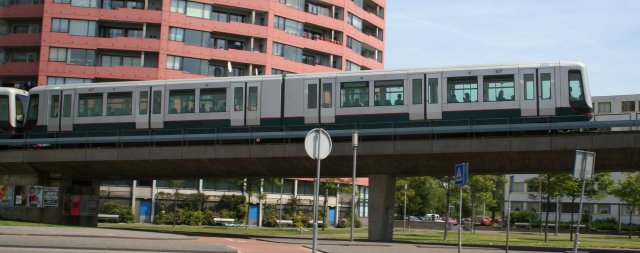Rotterdam Metro
Prototype

Spijkenisse train on the Erasmus Line, headed by 5353, on the ramp out of the Maas tunnel to Rijnhaven station
The Rotterdam Metro has two lines at present. They were formerly rather prosaically known as the north-south and east-west lines, but in 1997 they were officially named after two famous Rotterdammers, the philosopher Erasmus and the hydraulic engineer Pieter Caland.
Erasmus Line (North-South line)
This line was opened in stages between 1968 and 1985. It starts from Rotterdam Central Station (cs) and runs south through the city centre across the river, then roughly south-west to Hoogvliet and Spijkenisse. The city centre section and the two river crossings are in tunnel, the rest of the line on viaducts or embankments. The whole line is electrified on the third-rail system.
During the daytime roughly half the trains from cs turn back at Slinge, the rest run through to Spijkenisse.
The former Hofplein Line of Randstadrail is treated as part of the Erasmus Line. When the Blijdorp tunnel is completed (planned for 2008), Randstadrail will be physically connected to the Erasmus Line at cs, and Randstadrail trains will run through to Slinge.
Caland Line (East-West line)
This was opened between 1982 and 2002, the most recent part being Marconiplein to Tussenwater. There is interchange with the Erasmus Line at Beurs/Churchillplein station in the city centre, and with the railway at Rotterdam Alexander, Blaak and Schiedam Centrum.
At the eastern end there are three branches. The two branches through the Alexanderpolder to Ommoord and Zevenkamp had to be built for political reasons as semi-metro (sneltram) running at street level with overhead line; the branch to Capelle and the rest of the line are conventional third-rail metro on viaduct or in tunnel.
At the western end, the line ended for a long time at the Marconiplein, halfway between Rotterdam and Schiedam. It was extended in 2002 through Schiedam to the new second Benelux tunnel under the river. On the other side of the tunnel it joins the Erasmus Line at Tussenwater. Trains from Capelle run through to Spijkenisse; trains from the other two branches normally turn back at Schiedam Centrum.
There are plans to make the railway from Schiedam to Hoek van Holland part of the metro system: the Caland Line reversing sidings at Schiedam Centrum have been built in such a way that they can easily be linked up to the Hoek line.
Model
The Rotterdam Metro is linked to the Randstadrail project. I’m not (yet) planning on building a complete Rotterdam layout, particularly since there are already very good msts layouts available, but I am working on updating the Rotterdam stock models I made for earlier versions of Rail3D for use in connection with the Randstadrail layout.
Rolling stock
With the exception of the new Randstadrail stock, due to be delivered in 2008, the Rotterdam Metro has always used two-car articulated sets. Most trains consist of two to four units (single units are used on some Sunday and late evening services on the Caland Line).
Type M (mg2: 5000 and 5100 series)
The original stock for the north-south line, built by Werkspoor and Düwag, delivered in four batches from 1966 to 1973. Withdrawn 1999–2000 as the 5300s came into service. One unit is preserved. Apart from an occasional special working, they operated only on the Erasmus Line.
Type T (sg2: 5200 series)
Built by Düwag between 1980 and 1984 for the east-west line. To be able to operate as sneltrams in the Alexanderpolder they are fitted with pantographs and other tram-like equipment (turn indicators, brake lights, lifeguards, etc.) as well as third-rail pickups.
Because of political delays that prevented the ret from placing a firm order for Randstadrail stock in time for delivery before the planned opening, units 5261–5271 were provisionally adapted for use on the Hofplein line in 2005, and given the type designation rsg2. Apart from the livery, the only important change was the replacement of the Rotterdam cab-signalling equipment with the Siemens zub222c transponders needed for Randstadrail use.
Type B (mg2/1: 5300 series)
These form the second generation of stock for the Erasmus Line, built by Bombardier (formerly bn) in Bruges, and delivered in 1998 and 1999. Apart from electronic control systems and the modern look, a novelty for Rotterdam was that they were only fitted with one driving cab per unit, on the basis that trains always consist of at least two units. Since there are no loops or triangles on the network for turning trains round, it presumably requires a certain amount of forethought when making up trains not to end up without a driving cab at the right end…
Type S (sg2/1: 5400 series)
These 18 units were delivered in 2001–2002 to work on the extended Caland Line. They are essentially the same as the 5300s, apart from the pantographs and lights they need for sneltram use. The cab has an extra side window at the driving end to give the driver a better view at level crossings.
Randstadrail (rsg3/1)
These 21 three-car sets, due to be delivered in 2008, are also based on the 5300 design, but have a modified nose section that reflects the design of the Regio Citadis Randstadrail trams of the htm.
The ret has also ordered a further batch of these, in a different colour scheme, for use on the Caland Line and for metro operation to Hoek van Holland. They are intended to replace the sg2.
Apart from the three-car formation, the most shocking departure from previous Rotterdam practice is the introduction of padded seats. These are required because Randstadrail services run into The Hague, where passengers are not accustomed to the Spartan levels of comfort usual in Rotterdam…
Resources
import